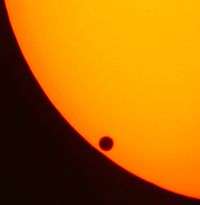Timeline of Solar System astronomy
Antiquity
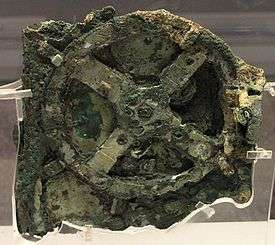
The Antikythera mechanism (Fragment A – front); visible is the largest gear in the mechanism, approximately 140 millimetres (5.5 in) in diameter
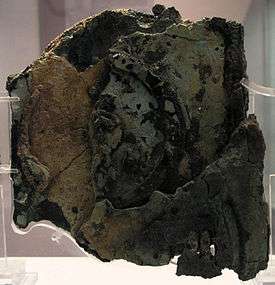
The Antikythera mechanism (Fragment A – back)
- 2nd millennium BC – earliest possible date for the composition of the Babylonian Venus tablet of Ammisaduqa, a 7th-century BC copy of a list of observations of the motions of the planet Venus, and the oldest planetary table currently known.
- 2nd millennium BC – Babylonian astronomers identify the inner planets Mercury and Venus and the outer planets Mars, Jupiter and Saturn, which would remain the only known planets until the invention of the telescope in early modern times.[1]
- 2nd millennium BC – Chinese astronomers record a solar eclipse
- 2nd millennium BC – Chinese determine that Jupiter needs 12 years to complete one revolution of its orbit.
- c. 1400 BC – Chinese record the regularity of solar and lunar eclipses and the earliest known Solar prominence
- c. 1100 BC – Chinese first determine the spring equinox.
- 776 BC – Chinese make the earliest reliable record of a solar eclipse.
- 7th century BC – Egyptian astronomers alleged to have predicted a solar eclipse
- 613 BC, July – A Comet, possibly Comet Halley, is recorded in Spring and Autumn Annals by the Chinese
- 586 BC – Thales of Miletus alleged to have predicted a solar eclipse
- c. 450 BC: Anaxagoras shows that the Moon shines by reflected sunlight.
- 350 BC – Aristotle argues for a spherical Earth using lunar eclipses and other observations
- 280 BC – Aristarchus of Samos offers the first definite discussion of the possibility of a heliocentric cosmos, and uses the size of the Earth's shadow on the Moon to estimate that the Moon's radius is one-third that of the Earth, and to estimate sizes and distances for the Moon and Sun
- 200 BC – Eratosthenes uses shadows to determine that the radius of the Earth is roughly 6,400 km
- 150 BC – Hipparchus uses parallax to determine that the distance to the Moon is roughly 380,000 km
- 134 BC – Hipparchus discovers the precession of the equinoxes
- 87 BC — The Antikythera mechanism, the earliest known computer, is built. It is designed to predict the movements of the Planets.
- 28 BC – Chinese history book Book of Han makes earliest known dated record of sunspot.
- c. 150 CE – Claudius Ptolemy completes his Almagest that codifies the astronomical knowledge of his time and cements the geocentric model in the West
Middle Ages
- 499 – The Indian astronomer-mathematician, Aryabhata, in his Aryabhatiya, propounds a possibly heliocentric solar system of gravitation, and an eccentric epicyclic model of the planets, where the planets follow elliptical orbits around the Sun, and the Moon and planets shine by reflected sunlight
- 500 – Aryabhata accurately computes the Earth's circumference, the solar and lunar eclipses, and the length of Earth's revolution around the Sun
- 620s – Indian mathematician-astronomer Brahmagupta recognizes gravity as a force of attraction, and briefly describes a law of gravitation
- 628 – Brahmagupta gives methods for calculations of the motions and places of various planets, their rising and setting, conjunctions, and calculations of the solar and lunar eclipses
- 687 – Chinese make earliest known record of meteor shower
- 9th century – The eldest Banū Mūsā brother, Ja'far Muhammad ibn Mūsā ibn Shākir, hypothesizes that the heavenly bodies and celestial spheres are subject to the same laws of physics as Earth, and proposes that there is a force of attraction between heavenly bodies
- 820 – the Persian astronomer, Muhammad ibn Musa al-Khwarizmi, composes his Zij astronomical tables, utilising Arabic numerals and the Hindu-Arabic numeral system in his calculations
- 850 – Ahmad ibn Muhammad ibn Kathīr al-Farghānī (Alfraganus) gives values for the obliquity of the ecliptic, the precessional movement of the apogees of the Sun
- 10th century – Muhammad ibn Jābir al-Harrānī al-Battānī (Albatenius) discovers that the direction of the Sun's eccentricity is changing
- 900s (decade) – Ibn Yunus observes more than 10,000 entries for the Sun's position for many years using a large astrolabe with a diameter of nearly 1.4 metres
- 1019 – Abū Rayhān al-Bīrūnī observes and describes the solar eclipse on April 8 and the lunar eclipse on September 17 in detail, and gives the exact latitudes of the stars during the lunar eclipse
- 1031 – Abū Rayhān al-Bīrūnī calculates the distance between the Earth and the Sun in his Canon Mas’udicus
- 1150 – Indian mathematician-astronomer Bhāskara II, in the Siddhanta Shiromani, calculates the longitudes and latitudes of the planets, lunar and solar eclipses, risings and settings, the Moon's lunar crescent, syzygies, and conjunctions of the planets with each other and with the fixed stars, and explains the three problems of diurnal rotation
- 1150s – Bhaskara calculates the planetary mean motion, ellipses, first visibilities of the planets, the lunar crescent, the seasons, and the length of the Earth's revolution around the Sun to 9 decimal places.
- 1150s – Gerard of Cremona translates Ptolemy's Almagest from Arabic into Latin, eventually leading to its adoption by the Catholic Church as an approved text.
- c. 1200 – Fakhr al-Din al-Razi, in dealing with his conception of physics and the physical world, rejected the Aristotelian and Avicennian view of a single world, but instead proposed that there are "a thousand thousand worlds (alfa alfi 'awalim) beyond this world such that each one of those worlds be bigger and more massive than this world as well as having the like of what this world has."[2]
- c. 1300 – Ibn Qayyim Al-Jawziyya, in his criticism of astrology, recognized that the stars are much larger than the planets, and that Mercury is the smallest planet known to him.[3]
- c. 1350 – Ibn al-Shatir anticipates Copernicus by abandoning the equant of Ptolemy in his calculations of planetary motion, and he provides the first empirical model of lunar motion which accurately matches observations.
- c. 1514 – Nicolaus Copernicus states his heliocentric theory in Commentariolus
- 1543 – Copernicus publishes his heliocentric theory in De revolutionibus orbium coelestium
- c. 1570 — Tycho Brahe founds the first modern astronomical observatory.
- 1577 – "Tycho" uses parallax to prove that comets are distant entities and not atmospheric phenomena.
17th Century
- 1609 – Johannes Kepler states his first two empirical laws of planetary motion, stating that the orbits of the planets are elliptical rather than circular, and thus resolving many ancient problems with planetary models.
- 1610 – Galileo Galilei discovers Callisto, Europa, Ganymede, and Io, sees Saturn's planetary rings (but does not recognize that they are rings), and observes the phases of Venus, disproving the Ptolemaic system, though not the geocentric model
- 1619 – Johannes Kepler states his third empirical law of planetary motion
- 1655 – Giovanni Domenico Cassini discovers Jupiter's Great Red Spot
- 1656 – Christiaan Huygens identifies Saturn's rings as rings and discovers Titan
- 1665 – Cassini determines the rotational speeds of Jupiter, Mars, and Venus
- 1672 – Cassini discovers Iapetus and Rhea
- 1672 – Jean Richer and Cassini measure the astronomical unit to be about 138,370,000 km
- 1675 – Ole Rømer uses the orbital mechanics of Jupiter's moons to estimate that the speed of light is about 227,000 km/s
- 1686 – Cassini discovers Tethys and Dione
18th century
- 1705 – Edmond Halley publicly predicts the periodicity of Halley's Comet and computes its expected path of return in 1757
- 1715 – Edmond Halley calculates the shadow path of a solar eclipse
- 1716 – Edmond Halley suggests a high-precision measurement of the Sun-Earth distance by timing the transit of Venus
- 1718 – Edmond Halley discovers proper motion, dispelling the concept of the "fixed stars".
- 1729 – James Bradley determines the cause of the aberration of starlight, providing the first direct evidence of the Earth's motion
- 1755 – Immanuel Kant first formulates the nebular hypothesis of Solar System formation.
- 1758 – Johann Palitzsch observes the return of Halley's comet. The interference of Jupiter's orbit had slowed the return by 618 days. Parisian astronomer La Caille suggests it should be named Halley's comet.
- 1766 – Johann Titius finds the Titius-Bode rule for planetary distances
- 1772 – Johann Bode publicizes the Titius-Bode rule for planetary distances
- 1781 – William Herschel discovers Uranus during a telescopic survey of the northern sky
- 1787 – Herschel discovers Uranus's moons Titania and Oberon
- 1789 – Herschel discovers Saturn's moons Enceladus and Mimas
- 1796 – Pierre Laplace re-states the nebular hypothesis for the formation of the Solar System from a spinning nebula of gas and dust
19th century
- 1801 – Giuseppe Piazzi discovers the dwarf planet–asteroid Ceres
- 1802 – Heinrich Wilhelm Olbers discovers the asteroid Pallas
- 1821 – Alexis Bouvard detects irregularities in the orbit of Uranus
- 1825 – Pierre Laplace completes his study of gravitation, the stability of the Solar System, tides, the precession of the equinoxes, the libration of the Moon, and Saturn's rings in Mécanique Céleste
- 1838 – Friedrich Wilhelm Bessel measures the parallax of the star 61 Cygni, refuting one of the oldest arguments against heliocentrism.
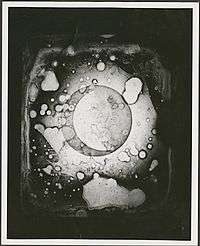
The earliest surviving dagerrotype of the Moon by Draper (1840)
- 1840 — John W. Draper takes a daguerreotype of the Moon, the first astronomical photograph.
- 1843 – John Adams predicts the existence and location of Neptune from irregularities in the orbit of Uranus
- 1846 – Urbain Le Verrier predicts the existence and location of Neptune from irregularities in the orbit of Uranus
- 1846 – Johann Galle discovers Neptune
- 1846 – William Lassell discovers Triton
- 1848 – Lassell, William Cranch Bond and George Phillips Bond discover Saturn's moon Hyperion
- 1849 – Édouard Roche finds the limiting radius of tidal destruction and tidal creation for a body held together only by its self gravity, called the Roche limit, and uses it to explain why Saturn's rings do not condense into a satellite
- 1851 – Lassell discovers Uranus's moons Ariel and Umbriel
- 1856 – James Clerk Maxwell demonstrates that a solid ring around Saturn would be torn apart by gravitational forces and argues that Saturn's rings consist of a multitude of tiny satellites
- 1862 – By analysing the spectroscopic signature of the Sun and comparing it to those of other stars, Father Angelo Secchi determines that the Sun is itself a star.
- 1866 – Giovanni Schiaparelli realizes that meteor streams occur when the Earth passes through the orbit of a comet that has left debris along its path
- 1877 – Asaph Hall discovers Mars's moons Deimos and Phobos
- 1892 – Edward Emerson Barnard discovers Jupiter's moon Amalthea
- 1899 – William Henry Pickering discovers Saturn's moon Phoebe
1900–1958
- 1906 – Max Wolf discovers the Trojan asteroid Achilles
- 1915 – Robert Innes discovers Proxima Centauri, the closest star to Earth after the Sun
- 1919 – Arthur Stanley Eddington uses a solar eclipse to successfully test Albert Einstein's General Theory of Relativity
- 1930 – Clyde Tombaugh discovers Pluto

The first photo from space was taken from a V-2 launched by US scientists on 24 October 1946.
- 1930 – Seth Nicholson measures the surface temperature of the Moon
- 1935 — The Explorer II balloon reached a record altitude of 22,066 m (72,395 ft), enabling its occupants to photograph the curvature of the Earth for the first time.
- 1944 – Gerard Kuiper discovers that the satellite Titan has a substantial atmosphere
- 1946 – American launch of a camera-equipped V-2 rocket provides the first image of the Earth from space
- 1949 – Gerard Kuiper discovers Uranus's moon Miranda and Neptune's moon Nereid
- 1950 – Jan Oort suggests the presence of a cometary Oort cloud
- 1951 – Kuiper argues for an annular reservoir of comets between 40-100 astronomical units from the Sun, the Kuiper belt
1958-1976
- 1959 — Explorer 6 sends the first image of the entire earth from Space.
- 1959 – Luna 3 sends the first images of another celestial body, the Moon, from space, including its unseen far side.
- 1962 – The Mariner 2 Venus flyby performs the first closeup observations of another planet
- 1964 – The Mariner 4 spacecraft provides the first detailed images of the surface of Mars
- 1966 – The Luna 9 Moon lander provides the first images from the surface of another celestial body
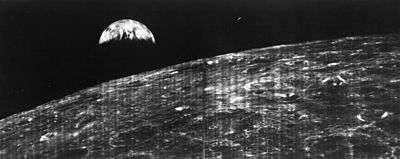
Earth taken from Lunar Orbiter 1 in 1966. Image as originally shown to the public displays extensive flaws and striping.
- 1967 – Venera 4 provides the first information on Venus's atmosphere
- 1968 – The Apollo 8 becomes the first manned lunar mission, providing historic images of the whole Earth.
- 1970 – The Venera 7 Venus lander sends back the first information ever successfully obtained from the surface of another planet
- 1971 – The Mariner 9 Mars spacecraft becomes the first to successfully orbit another planet. It provides the first detailed maps of the Martian surface, discovering much of the planet's topography, including the volcano Olympus Mons and the canyon system Valles Marineris, which is named in its honor.
- 1971 – Mars 3 lands on Mars, and transmits the first partial image from the surface of another planet.
- 1973 – Skylab astronauts discover the Sun's coronal holes.
- 1973 – Pioneer 10 flies by Jupiter, providing the first closeup images of the planet and revealing its intense radiation belts.
- 1973 — Mariner 10 provides the first closeup images of the clouds of Venus.
- 1974 – Mariner 10 provides the first closeup images of the surface of Mercury.
- 1975 – Venera 9 becomes the first probe to successfully transmit images from the surface of Venus.
1977–2000
- 1977 – James Elliot discovers the rings of Uranus during a stellar occultation experiment on the Kuiper Airborne Observatory
- 1977 – Charles Kowal discovers 2060 Chiron, the first Centaur
- 1978 – James Christy discovers Charon, the large moon of Pluto.
- 1978 – The Pioneer Venus probe maps the surface of Venus.
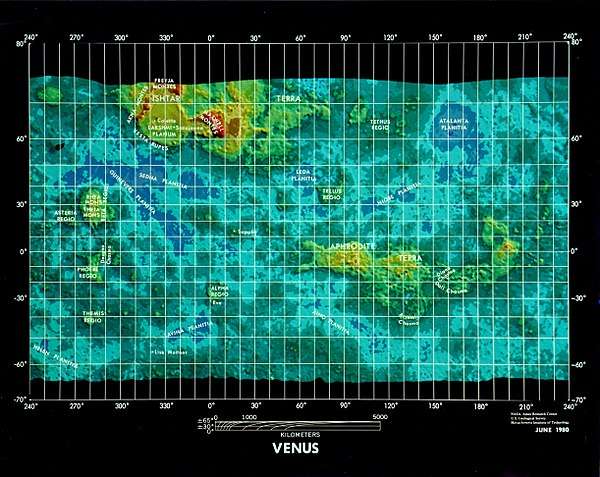 A map of Venus produced from Magellan data
A map of Venus produced from Magellan data - 1978 – Peter Goldreich and Scott Tremaine present a Boltzmann equation model of planetary-ring dynamics for indestructible spherical ring particles that do not self-gravitate and find a stability requirement relation between ring optical depth and particle normal restitution coefficient
- 1979 – Pioneer 11 flies by Saturn, providing the first ever closeup images of the planet and its rings. It discovers the planet's F ring and determines that its moon Titan has a thick atmosphere.
- 1979 – Voyager 1 flies by Jupiter and discovers its faint ring system, as well as volcanoes on Io, the innermost of its Galilean moons.
- 1979 – Voyager 2 flies by Jupiter and discovers evidence of an ocean under the surface of its moon Europa.
- 1980 – Voyager 1 flies by Saturn and takes the first images of Titan. However, its atmosphere is opaque to visible light, so its surface remains obscured.
- 1986 – Voyager 2 provides the first ever detailed images of Uranus, its moons and rings.
- 1986 – The Giotto probe provides the first ever close up images of Halley's Comet.
- 1988 – Martin Duncan, Thomas Quinn, and Scott Tremaine demonstrate that short-period comets come primarily from the Kuiper Belt and not the Oort cloud
- 1989 – Voyager 2 provides the first ever detailed images of Neptune, its moons and rings.
- 1990 – The Hubble Space Telescope is launched
- 1990 – Voyager 1 is turned around to take the Portrait of the Planets of the Solar System, source of the Pale Blue Dot image of the Earth
- 1991 – The Magellan spacecraft maps the surface of Venus.
- 1992 – First planetary system beyond the Solar System detected, around the pulsar PSR B1257+12
- 1992 – David Jewitt and Jane Luu of the University of Hawaii discover 15760 Albion, the first object deemed to be a member of the Kuiper belt
- 1995 – The first planet around a Sun-like star is discovered, in orbit around the star 51 Pegasi.
- 1995 – The Galileo spacecraft becomes the first to orbit Jupiter. Its atmospheric entry probe provides the first data taken within the planet itself.
- 2000 – NEAR Shoemaker provides the first detailed images of a near-Earth asteroid.
2001–present
- 2003 – Sedna, a large object with an unprecedented 12,000-year orbit, is discovered by Michael E. Brown, Chad Trujillo, and David L. Rabinowitz.
- 2004 – Voyager 1 sends back the first data ever obtained from within the Solar System's heliosheath.
- 2004 – The Cassini–Huygens spacecraft becomes the first to orbit Saturn. It discovers complex motions in the rings, several new small moons and cryovolcanism on the moon Enceladus and provides the first images from the surface of Titan.
- 2005 – Michael E. Brown et al. discover Eris, a trans-Neptunian object larger than Pluto, and later also its moon, Dysnomia. Eris was first imaged in 2003, and is the largest object discovered in the Solar System since Neptune's moon Triton in 1846.
- 2005 – The Mars Exploration Rovers perform the first astronomical observations ever taken from the surface of another planet, imaging an eclipse by Mars's moon Phobos.
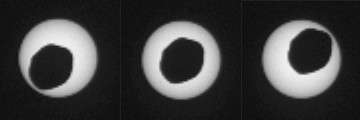
Annular eclipse of the Sun by Phobos as viewed by the Mars Curiosity rover (20 August 2013).
- 2006 – The 26th General Assembly of the IAU voted in favor of a revised definition of a planet and officially declared Ceres, Pluto, and Eris dwarf planets.
- 2008 – The IAU declares Makemake and Haumea dwarf planets.
- 2011 – The Dawn spacecraft enters orbit around the large asteroid Vesta making detailed measurements.
- 2012 – Saturn's moon Methone is imaged up close by the Cassini spacecraft, revealing a remarkably smooth surface.
- 2012 – The Dawn spacecraft breaks orbit of Vesta and heads for Ceres.
- 2013 - The MESSENGER spacecraft provides the first ever complete map of the surface of Mercury
- 2015 – The Dawn spacecraft enters orbit around the dwarf Planet Ceres making detailed measurements.
- 2015 – The New Horizons spacecraft flies by Pluto, providing the first ever images of its surface.
- 2017 - 'Oumuamua, the first known interstellar object, is identified.
See also
References
- ↑ A. Sachs (May 2, 1974), "Babylonian Observational Astronomy", Philosophical Transactions of the Royal Society of London, Royal Society of London, 276 (1257): 43-50 [45 & 48-9], Bibcode:1974RSPTA.276...43S, doi:10.1098/rsta.1974.0008, JSTOR 74273
- ↑ Adi Setia (2004), "Fakhr Al-Din Al-Razi on Physics and the Nature of the Physical World: A Preliminary Survey", Islam & Science, 2, archived from the original on 2012-07-10, retrieved 2010-03-02
- ↑ Livingston, John W. (1971), "Ibn Qayyim al-Jawziyyah: A Fourteenth Century Defense against Astrological Divination and Alchemical Transmutation", Journal of the American Oriental Society, 91 (1): 96–103 [99], doi:10.2307/600445
This article is issued from
Wikipedia.
The text is licensed under Creative Commons - Attribution - Sharealike.
Additional terms may apply for the media files.
